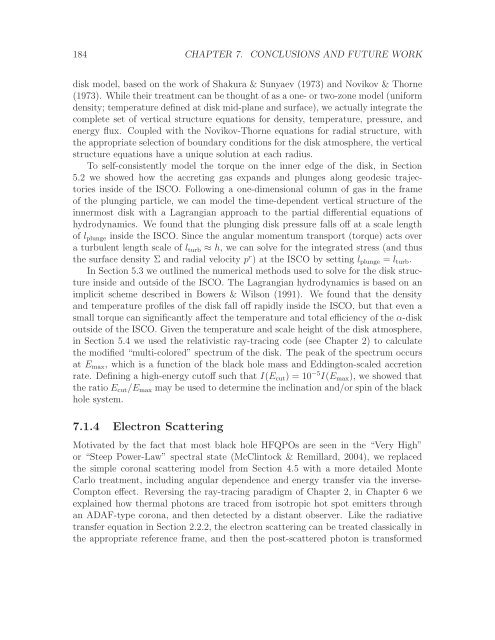Radiation Transport Around Kerr Black Holes Jeremy David ...
Radiation Transport Around Kerr Black Holes Jeremy David ...
Radiation Transport Around Kerr Black Holes Jeremy David ...
You also want an ePaper? Increase the reach of your titles
YUMPU automatically turns print PDFs into web optimized ePapers that Google loves.
184 CHAPTER 7. CONCLUSIONS AND FUTURE WORK<br />
disk model, based on the work of Shakura & Sunyaev (1973) and Novikov & Thorne<br />
(1973). While their treatment can be thought of as a one- or two-zone model (uniform<br />
density; temperature defined at disk mid-plane and surface), we actually integrate the<br />
complete set of vertical structure equations for density, temperature, pressure, and<br />
energy flux. Coupled with the Novikov-Thorne equations for radial structure, with<br />
the appropriate selection of boundary conditions for the disk atmosphere, the vertical<br />
structure equations have a unique solution at each radius.<br />
To self-consistently model the torque on the inner edge of the disk, in Section<br />
5.2 we showed how the accreting gas expands and plunges along geodesic trajectories<br />
inside of the ISCO. Following a one-dimensional column of gas in the frame<br />
of the plunging particle, we can model the time-dependent vertical structure of the<br />
innermost disk with a Lagrangian approach to the partial differential equations of<br />
hydrodynamics. We found that the plunging disk pressure falls off at a scale length<br />
of l plunge inside the ISCO. Since the angular momentum transport (torque) acts over<br />
a turbulent length scale of l turb ≈ h, we can solve for the integrated stress (and thus<br />
the surface density Σ and radial velocity p r ) at the ISCO by setting l plunge = l turb .<br />
In Section 5.3 we outlined the numerical methods used to solve for the disk structure<br />
inside and outside of the ISCO. The Lagrangian hydrodynamics is based on an<br />
implicit scheme described in Bowers & Wilson (1991). We found that the density<br />
and temperature profiles of the disk fall off rapidly inside the ISCO, but that even a<br />
small torque can significantly affect the temperature and total efficiency of the α-disk<br />
outside of the ISCO. Given the temperature and scale height of the disk atmosphere,<br />
in Section 5.4 we used the relativistic ray-tracing code (see Chapter 2) to calculate<br />
the modified “multi-colored” spectrum of the disk. The peak of the spectrum occurs<br />
at E max , which is a function of the black hole mass and Eddington-scaled accretion<br />
rate. Defining a high-energy cutoff such that I(E cut ) = 10 −5 I(E max ), we showed that<br />
the ratio E cut /E max may be used to determine the inclination and/or spin of the black<br />
hole system.<br />
7.1.4 Electron Scattering<br />
Motivated by the fact that most black hole HFQPOs are seen in the “Very High”<br />
or “Steep Power-Law” spectral state (McClintock & Remillard, 2004), we replaced<br />
the simple coronal scattering model from Section 4.5 with a more detailed Monte<br />
Carlo treatment, including angular dependence and energy transfer via the inverse-<br />
Compton effect. Reversing the ray-tracing paradigm of Chapter 2, in Chapter 6 we<br />
explained how thermal photons are traced from isotropic hot spot emitters through<br />
an ADAF-type corona, and then detected by a distant observer. Like the radiative<br />
transfer equation in Section 2.2.2, the electron scattering can be treated classically in<br />
the appropriate reference frame, and then the post-scattered photon is transformed
















